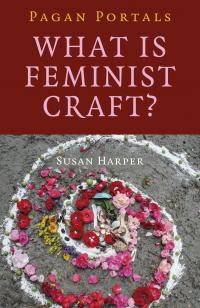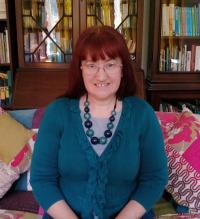
 The Queer of Heaven: Goddess Culture and the Empowerment of Gay Women and Men (This essay first appeared in Naming the Goddess)
The Queer of Heaven: Goddess Culture and the Empowerment of Gay Women and Men (This essay first appeared in Naming the Goddess)
David Salisbury
For I am divided for love’s sake for the chance of union. This is the creation of the world, that the pain of division is as nothing, and the joy of dissolution all. For these fools of men and their woes care not thou at all! They feel little; what is, balanced by weak joys; but ye are my chosen ones. [AL 1.29-31, The Book of the Law, Aleister Crowley]
When I was trained in American Wicca as a kid, I learned very early on that everything has its holy place in the world and universe. I was taught that everything on Earth has a correspondence that matches some things in the world of spirit. Red is for love, green is for money, and ground pepper keeps thieves away. Part of learning correspondences meant learning about what natural things represent the Goddess (the Divine Female) and the God (the Divine Male). Most often these were things that went together, usually in a procreative way. For example, the witch’s knife, the athame, is always to the male as the chalice cup is always to the female. It was understood early on that we do this because the regenerative powers that the Goddess and God bring forth through their union is the most holy mystery in the Craft. I agreed with this for several years.
As a couple of years passed in my training, I started to grow up and change. As always happens in the teenage years, I discovered all kinds of things about myself. One of them was that I had an attraction to the same sex. I realized very quickly that I was gay and that my whole life would be a little more different because of that. The unique part of that process was that I wasn’t concerned about what my family thought or even my friends at school. Instead, I was worried and confused about what that meant for my relationship with my Gods. After all, the Goddess and God have to be heterosexual, right? It didn’t seem to fit well within my new worldview, but I accepted that as much as I could. I figured out that if I just removed the idea of my physical nature from that picture, then I could resolve to still love my Gods and see myself in them.
Years went by throughout my teen years when the thought of removing myself from the cycle of the Gods felt comfortable enough to me. But that all changed the older I got and the more deeply I experienced the gnosis of the divine first-hand. I realized that everything isn’t as black and white as I assumed it was. And, most importantly, I realized that in this ecstatic experience-based practice I call Witchcraft, it was no longer possible for me to remove myself from the image of the Gods. So I set out to resolve my queer physical self with the powers I adored.
If you look up information about “queer” Gods and Goddesses for the first time, you may be surprised at what you find. I certainly was! While I was expecting a couple of queer Gods scattered throughout the abyss of our world’s history, I instead found a rich collection of what might be referred to as the “Queer Mythos.” I use this term when I talk about any Goddess or God that, while not necessarily homosexual in their myths, displays some kind of attribute that resonates with the queer heart or thought process.
It’s actually quite easy to discover and learn about queer male-identified Gods. The ancient world is filled with myths of Gods who sport with other male Gods, come to Earth and have affairs with mortal men, or transform themselves into women for a time for a tryst with a mortal man. But what of the Goddesses?
The mysteries of the queer Goddesses are a bit more elusive, hidden within the shadows cast by moonlight, as is her signature method of wisdom delivery. The first place to look is her ancient forms and human followers. The Goddesses Artemis, Ishtar, and Inanna all had cults dedicated to them where both queer women and men were commonly priests. Inanna in particular is a Goddess who embodies the independent woman, refusing to simply be a pawn in her husband’s kingdom and taking the throne for herself. It is her alignment with wisdom and power, rather than her subservience to an opposite-gender partner that gives her the status of “Queen of Heaven.”
In the Aztec people we find Huastecs, transgender or lesbian priestesses protected by the Goddesses Tlazoteotl and Xochiquetzal. Tlazoteotl is known as the “Filth Eater” who turns suffering into gold – surely a powerful display of sovereignty and championship over the downtrodden.
In Haitian Voodoo we find the Lwa Erzulie Fréda Dahomey, who reigns over the powers of love and passion. I have been told by friends in the Voodoo community that the men she “inhabits” during her rites will sometimes display homosexual traits and actions, regardless of their usual sexual orientation. Erzulie Fréda is thought to correspond to gay men while Erzulie Dantor is connected to lesbian women.
The classical myths of Greece present us with plethora of stories relating to the queer Goddess. Above all stories stands Aphrodite, Goddess of the love of all people, including those attracted to the same gender, along with her accompanying Gods Eros, Himeros and Pothos. The writings of the Greek poet Sappho identify Aphrodite as having particular guardianship over lesbian women. Aphrodite is so famous in queer myth that she later takes on a mostly-male image in the form of Aphroditus, her male form worshipped on the island of Cyprus.
In the modern-day western world with its newfound acceptance and respect for lesbian, gay, bisexual, and transgender individuals, it’s easy to find queer followers to the Goddess in all her guises. The Dianic tradition of Wicca, founded by Zsusanna Budapest, is a Goddess-based tradition that welcomes both lesbian and straight women to worship the Goddess in her many facets, including sometimes her queer nature (depending on the coven or line you speak with). For men, the Minoan Brotherhood and Brotherhood of the Phoenix are two well-known traditions for gay men that fully embrace the concept of a queer Goddess and a queer God. They explore the mysteries of the Gods by working with each other, other queer Goddess-worshippers. The idea being that the divine is firmly present within the self and is reflected out of every individual identity, including queer identity.
The Feri tradition of witchcraft, founded by the late Victor and Cora Anderson in the United States, is an interesting example of a tradition where queer divinity is highly present and obvious. In the Feri mythos, God Hirself gazed into the black void of space and fell in love with her perfect, holy nature. Upon the height of her pleasure, the universe erupted in a cascade of ecstatic power, rippling through time and forming the other divine reflections of her beings, the other Gods. The Blue God is the first male emanation of this Star Goddess. He is called a “he” often for convenience sake, but shares very obvious ambiguous traits. He is youthful and playful, often seen with both an erect phallus and the newly-forming breasts of a young woman at the same time. He is as queer as the Goddess who birthed him, for she is him and he is her. And out of their holy creation, we are born from the same qualities.
This idea that the Goddess can be queer because many of us are is the banner point made mostly by queer practitioners of modern-day Wicca and witchcraft. Original Gardnerian Wicca was sometimes seen as homophobic because Gerald Gardner was often insistent on the idea that the power must be passed from man to woman and from woman to man. There is no evidence to suggest that Gardner took this idea into the area of human sexual relationships as well, but the debate still rages on today. In any case, the typical Wiccan coven spent many decades under the influence of a male High Priest and a female High Priestess, without any other option. But things are much different today. Today, most Wiccans will tell you that the power can be passed through any individuals who can possess and receive it. Why? Because we each have traits of the two within us. In some circles, having a queer nature is thought to grant one a special relationship to the Goddess and God simply because the queer Wiccan is thought to embody the traits of both so strongly. This is an old idea and is portrayed beautifully in the concept of the “Two-Spirit” people of some Native American tribes.
I end this short musing on the queer Goddess where we began, with the excerpt from The Book of the Law from the Thelema religion. These words are spoken by Nuit, the Star Goddess who is divided unto herself, for the chance of union. Gendering and sexualizing the Goddess can be a helpful way for our human brains to understand and take part in her holy mysteries, but only if we avoid falling into the trap of limits and constraints. If the Goddess is truly the limitless expansion of the All, then it must stand that her divine love and lust is just as limitless. She is “divided” but only for the sake of love. The dissolution of her being is truly the reunification of her presence in all things. The great alchemists of the Middle Ages knew this, and so are the Goddess-worshippers of the modern day remembering this now.
If the resurgence of the Goddess in the present day has taught us anything, it could be that the downtrodden and misunderstood will never fully retreat when the forces of oppression are thrust upon them. The queer Goddesses in all their forms seemed for a moment to be lost to the mists of time, frozen in place by the violent uprising of patriarchy. Just as her queer devotees have risen up out of the ashes of defeat to claim their rights, so too is she making herself known once more.
David Salisbury is Wiccan clergy within Coven of the Spiral Moon, a coven based in Washington DC and author of The Deep Heart of Witchcraft and A Mystic Guide to Cleansing and Clearing.
Categories:
0 comments on this article






